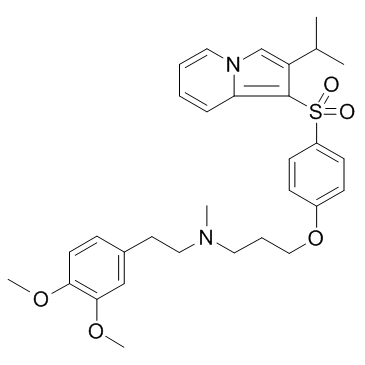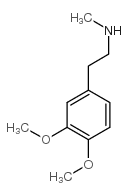114432-13-2
| Name | N-[2-(3,4-dimethoxyphenyl)ethyl]-N-methyl-3-[4-(2-propan-2-ylindolizin-1-yl)sulfonylphenoxy]propan-1-amine |
|---|---|
| Synonyms |
Fantofaronum
Fantofarona Fantofarone |
| Description | Fantofarone is a highly potent Calcium Channel antagonist. |
|---|---|
| Related Catalog | |
| Target |
Calcium Channel[1]. |
| In Vitro | It can be seen that the calcium channel blockers VIZ and Fantofarone (SR) possess a weak intrinsic antimalarial property compared to CQ, and both appear slightly more potent on the CQ-resistant than on the CQ-sensitive parasites. Interestingly, Fantofarone is ca. 10 times more potent than verapamil. Fantofarone (SR) is 10 times more potent than the phenylalkylamine verapamil (VR) on the two P. fdciparum strains. As revealed by the isobolograms, the two calcium channel blockers potentiate the CQ sensitivity activity on the CQ-resistant P. fufcipurum strain, verapamil appearing 2 to 3 times more potent than Fantofarone. Furthermore, when used at similar subinhibitory fractions of their IC50, VR is 2 to 3 times more potent than Fantofarone in decreasing CQ resistance[1]. |
| In Vivo | Treatment with isosorbide dinitrate (0.3 mg/kg, i.v.) or Fantofarone (50 mg/kg, i.v.), a reduction is observed in the occurrence and severity of vasospasm, whereas verapamil (0.2 mg/kg, i.v.) is much less effective. Although it totally inhibits distal AIV, isosorbide dinitrate does not significantly affect proximal diameter decrease. The most potent compound with regard to both the distal and proximal vasospasms is Fantofarone, which significantly reduces AIV throughout the experiment. Verapamil does not reduce AIV significantly[2]. |
| Animal Admin | Rabbits[2] Male White rabbits are used in this study (3.0-3.2 kg). All surgical procedures are performed under anaesthesia with a mixture of ketamine and xylazine. At the end of the experiments, the animals are sacrificed by a pentobarbital overdose. The proximal femoral arteries are exposed, and the isolated arterial segments are desiccated by air infusion delivered at a rate of 80 mL/min for 8 min. After desiccation is completed, the ligatures are released and flow is restored. At the day of surgery, a 2% cholesterol/6% peanut oil diet is started for 2 weeks. Before angioplasty, the animals are randomized in 4 groups of 10 animals:1. Placebo, 1 mL/kg of NaCl 0.9%, 2. Isosorbide dinitrate, 0.3 mg/kg, 3. Verapamil, 0.2 mg/kg, 4. Fantofarone, 50 mg/kg. The doses of isosorbide dinitrate, verapamil, and fantofarone are defined in a pilot experiment as the highest doses which did not show any hypotensive effect per se and are chosen very carefully according to their activity measured in other pharmacological models[2]. |
| References |
| Density | 1.16g/cm3 |
|---|---|
| Molecular Formula | C31H38N2O5S |
| Molecular Weight | 550.70900 |
| Exact Mass | 550.25000 |
| PSA | 77.86000 |
| LogP | 6.93690 |
| Index of Refraction | 1.573 |
| Storage condition | 2-8℃ |



